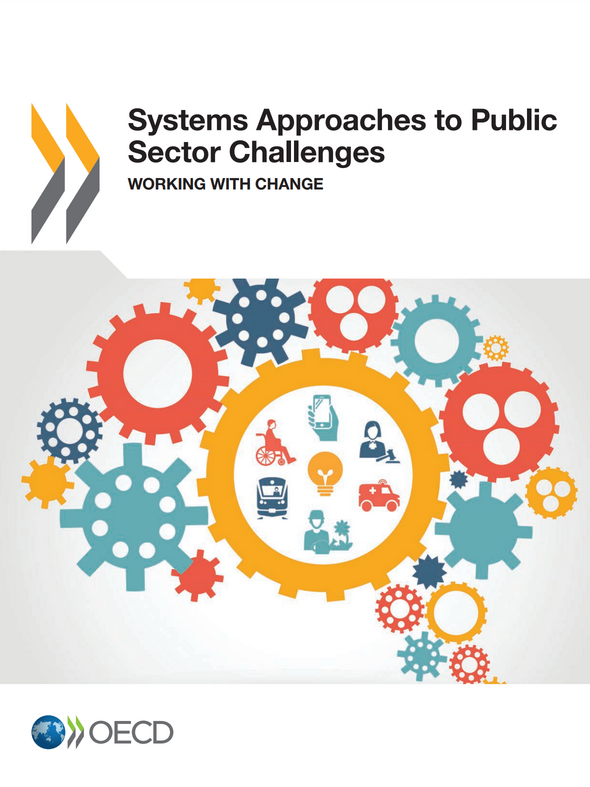Systems Approaches to Public Sector Challenges: Working with change

Overview
Governments are increasingly confronted by uncertain and complex challenges whose scale and nature call for new approaches to problem solving. Some governments have started to use systems approaches in policy making and service delivery to tackle complex or “wicked” problems in areas ranging from education to ageing, healthcare and mobility. Systems approaches refer to a set of processes, methods and practices that aim to effect systems change.
Adopting such an approach requires significant adjustments on the part of governments. It means moving away from traditional linear procedures, strategic planning and the notion of reform as an isolated intervention. Instead, policy makers need to focus on building capacity to forecast future scenarios and applying leadership to mobilise a broad range of actors to achieve a common good rather than narrow institutional interests.
Systems approaches help governments to confront problems that traverse administrative and territorial boundaries in a holistic manner. They call for constant adjustment throughout the policy cycle, with implications for the ways in which institutions, processes, skills and actors are organised. Because they focus on outcomes, systems approaches require multiple actors within and across levels of government to work together. To effect systems change, administrations must develop a vision for a desired future outcome, define the principles according to which that future system will operate, and start to implement a set of interventions that will transform the existing system into the future system.
Changing entire systems in the public sector is difficult, largely because public services must be continuously available – they cannot be turned off, redesigned and restarted. Systems approaches can help navigate this difficult transition by allowing new practices to be rolled out while core processes are still running. Furthermore, systems approaches can help organisations to better manage complexity by striking a balance between simplification (focusing on the intended outcome) and complexification (tackling multiple factors within a system at the same time). Changing the system also requires building internal skills into organisations to help them face and adapt to new circumstances.
Systems change invariably spurs debate about the relative value of policy choices, and the trade-offs to be made. For example, in the Canadian case of car-sharing, the flexible transportation system took precedence over other concerns such as precarious work conditions. In Iceland, domestic violence had to be reframed as a public health issue rather than a private matter.
“Independent brokers” can facilitate these value debates and create a level playing field for change. For example, an outside government lab, MaRS Solutions, was involved in changing the Toronto transportation system because all parties viewed it as a non-partisan participant. In Finland, the Nordic think tank Demos Helsinki was able to challenge the modus operandi of public sector institutions, thus creating the conditions for introducing experimentation in government.
Initiating and sustaining systems change over time also requires the involvement of senior management, especially when attempting to transform long-established and complex systems. However, leadership is not enough: the participation of a critical mass of actors representing different positions and roles – all of whom understand the need for change and are willing to act on it – is crucial for achieving results. In the Netherlands, the board of directors of the Amsterdam Child and Youth Protection Services supported a change process that lasted for over five years. In Iceland, the heads of police, social services and child protection had to work together to make domestic violence a priority.
Systems approaches require working across organisational boundaries and government levels. For example, in Canada there were concerted efforts at both the municipal and provincial level to help establish a sharing economy. In the Netherlands, although transforming the child protection system began with change in one organisation, it soon became clear that the rest of the supporting structures, from accompanying services to the legal framework, had to be reformed to achieve real results. Once systemic changes are institutionalised it becomes more difficult to return to the “old way of doing things”.
Meaningful measurement and feedback mechanisms function as the cornerstones of successful systems change. In policy making there is often a gap between policy design and implementation, especially when addressing complex problems. The case studies highlighted the need for measures that link directly to the purpose of systems, such as the Netherlands’ approach to child protection and Iceland’s risk assessment framework for domestic violence.
Time is an essential resource in systems change: people need to live through and experience the change rather than hearing about it from a third party. The timing of change is thus crucial. In order to implement the Experimental Policy Design programme in Finland, for example, stakeholders had to accelerate their discussions and insert the topic of experimentation into the next government programme during national elections.
Both the Dutch and the Icelandic cases illustrate the difficulties of rapidly scaling up change. In order for change to “stick”, people need time to internalise the solutions. Additionally, new, more agile and iterative financing measures must be created to support the use of systems approaches. In the cases of both Canada and Finland, dedicated non-government partners had to invest more time and energy into the projects than was initially planned. In the Dutch case, the initial investment needs exceeded the available resources of the organisation and had to be found elsewhere – though, ultimately, the change produced a 22% reduction in costs per service user. Better instruments are therefore needed to assess the initial return on investment and to track how benefits from systems change are realised and to whom they accrue. While this report provides some initial insights into the theory and practice of system approaches in the public sector, further work is needed to gather information from relevant experiences and to draw lessons from cases studies in order to develop guidance for policy makers undertaking systems change.

Systems Approaches to Public Sector Challenges: Working with change
Published on 11 August 2017.
